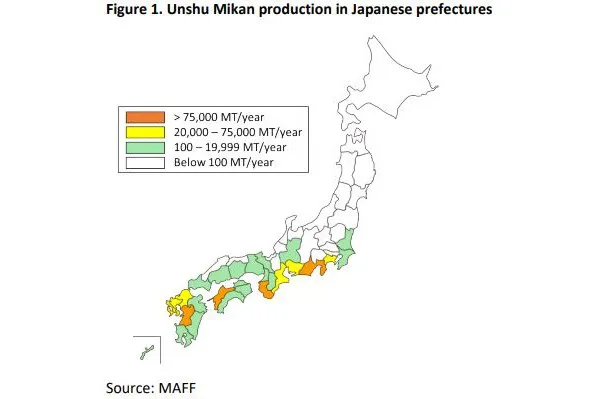Fruit cultivation in Japan is dominated by citrus production. In particular, growing mandarins - the Unshu Mikan and Chubankan varieties - and kumquats. Over the past 46 years, the country's citrus production share has, however, been dwindling.
This is due not only to aging growers. There is also a lack of workforce. Less fruit, in general, is being consumed in Japan too. About 60% of the sales are done via local sales. Internet sales are, however, on the rise.
Despite this lower consumption, Japan's fruit import total remains stable at 1,700,000 MT. The United States is this country's main supplier of, especially, oranges and lemons. The demand for lemons and lemon-like fruit is on the rise in Japan. This is according to the United States Department of Agriculture (USDA)'s Citrus Annual.
The new trade agreement between the US and Japan allows for attractive price tariffs for fresh American oranges. That is expected to increase sales.
Mandarins
The total area of mandarin orchards has decreased somewhat in recent years. It now stands at 54,100 ha. That, while production has increased slightly to 994,000 MT. The expectation is that the Unshu Mikan variety will be replaced. This change is due to this variety's poor harvest. It will make way for Chubankans and other lemony citrus fruit.

Japan imports mostly American mandarins, 13,000 MT of them. Mandarin total imports will grow to 19,000 MT in the coming year. This increase is due to the lower yields of mandarins in Japan.
Only seven percent of Japan's own mandarin production is processed into juice. The vast majority, 90%, are eaten fresh, with three percent ending up in the trash. Lower consumption has made for increased prices over the last ten years.
In 2018/2019, fewer fresh Japanese mandarins were exported. Compared to 2017/2018, this decreased by 36.3% or 1,012 MT. This decrease is due to competition from China and South Korea. Exports for 2019/2020 are estimated at 1,000 MT. This volume will mostly be sent to South-East Asia.
Oranges
Japan grows oranges in the Hiroshima and Shizuoka provinces. These differ from overseas oranges. They contain almost no residues. Aging farmers and the lack of workforce also threaten this production. It is expected that orange production will decline in 2019/2020. This will be at five percent or 370 ha, which will total 5,607 MT.
The Japanese prefer Navel oranges to the Valencia variety. People there eat mainly American varieties. That is because very few oranges are produced in Japan itself.
Fresh orange imports are thought to have risen in 2018/2019. This should have increased by three percent to 85,049 MT. Most of these oranges come from the US. A further increase is expected in 2019/2020. The total number of oranges imported should grow by 3,2% to 94,000 MT.
As stated, Japan itself produces very few oranges. The exportation of this product could, therefore, be neglected.
Grapefruit
Grapefruit consumption in Japan has been on the decline since 2004. This drop is due to media reports about the contra-indication of grapefruit with high blood pressure medications. It is mostly older people who eat this citrus fruit. These reports, therefore, affected consumption. Grapefruit is currently, however, used more in (alcoholic) fruit cocktails.
The prediction is that in 2019/2020, grapefruit production will shrink by four percent to 86,000 MT.
This fruit is imported mostly from South Africa, but also the US. In 2018/2019, these imports were expected to decrease by nine percent to 64,329 MT. This trend is likely to continue in 2019/2020. A further decline of 6,8% to 60,000 MT is expected.
Lemons and limes
More than 80% of Japan's lemons are cultivated in the Hiroshima and Ehime provinces. In 2018/2019, typhoons and frost caused considerable damage to these fruits in Hiroshima. A recovery is, however, expected. In 2019/2020, 8,000 MT should be produced.
In Japan, lemons are mostly used as garnishing. They are used in salad dressing and to spice foods too. Another use is in alcoholic fruit cocktails. Lemon consumption is on the rise in that country.
Lemon imports increased by 11,6%, to 56,839 MT in 2018/2019. This citrus fruit was mainly brought in from the United States. Imports should further increase by five percent in the coming year. A volume of 623,000 MT of lemons is expected to be imported.
Orange juice
Very few oranges are grown in Japan. These are mostly imported from Brazil. Orange consumption has decreased by 14% over the past five years. Since 2013, the Japanese have been drinking less fruit juice, in general. This decline is because orange juice has a high sugar and calorie content. Its consumption is expected to fall even more.
Source: Japan Citrus Annual by USDA (United States Department of Agriculture) – Foreign Agricultural Service
